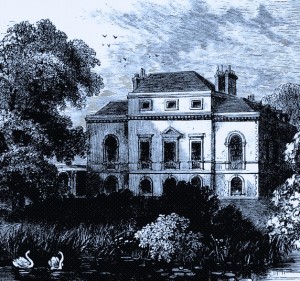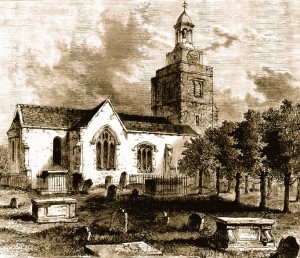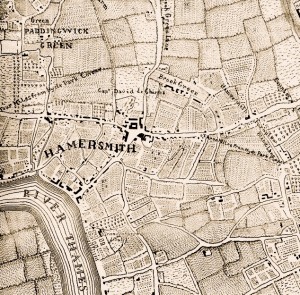Hammersmith, A Rural Village
Hammersmith was first known as Hamersmyth, perhaps due to the words ‘ham’ meaning village and ‘hythe’ meaning by the harbour; but it could have been more literally derived from hammer and smithy, relating to a place where metal work was done. Artefacts have been found in the area from Neolithic and Roman settlers. My favourite is the literal version.
Hammersmith began it’s life gently as a small hamlet, a “side” to the larger town of Fulham. Situated on the northern edge of the meandering River Thames, Hammersmith was once a marshy place, inclined to flooding, but where reed beds provided a living of basket making to its residents. Fishing, rearing pigs and keeping cows provided the early residents with food. The little hamlet grew blissfully slowly for a couple of centuries, but with fertile soil the residents of Hammersmith were able to successfully cultivate fruit and vegetables and went on to sell them in the City of London to the east, which was fast expanding.
By the 1600’s, Hammersmith, with its idyllic and romantic rural views along a wide bend of the river and beyond to the hills south of the Thames, had become a popular place for the aristocracy and wealthy persons of quality to build their country retreats and palaces.
In 1624, the Hammersmith residents, with help from the Earl of Mulgrave and Sir Nicholas Crispe a brick maker and slave trader, petitioned the Bishop of London for a Chapel of Ease to be built. The arduous walk from Hammersmith to All Saints Church in Fulham, sometimes impassable in bad weather, had become too much to tolerate. With residents money, and their promise to pay for the upkeep, St Paul’s Church was built in Queen Street, now Queen Caroline Street, and consecrated in 1631.
Market gardening was now becoming firmly established: maps show just how many market gardens surrounded the early network of streets, lanes and roads – some recognisable to this day. Coaching Inns were springing up in abundance along the main routes for changing tired horses, making coach repairs and providing travellers with food and board.
A main link going from the Broadway down to the river and various wharfs, brought and sent goods by barge up, down and south of the river. The streets were already dotted with houses and employment was plentiful.
With its good links, yet still with a very rural and charming aspect, Hammersmith flourished. Despite all this, Hammersmith didn’t become an independent parish until 1834.
At some time during the mid 1700’s my Ancestor, Thomas Randell, moved to Hammersmith, and his first son, also Thomas, was Christened in St Paul’s Church in 1781. Young Thomas, my 4 times great grandfather, became a timber dealer. He lived in Waterloo Road and, according to Booths Poverty Maps, had a fairly middle class living. Waterloo Road no longer exists but it was near the Thames and not far from a timber warehouse by St Peter’s Wharf. He had 8 children – most of whom were christened and Married at St Paul’s.
This began an over 200 year love affair between Hammersmith and its Church and the fast increasing number of Randell’s, their children, spouses, grandchildren and beyond. My daughter was born in Queen Charlotte’s Hospital, near to where my Grandmother lived until her death in 1975.
St. Paul’s records are heavy with my relatives names and its walls have echoed the sounds of their voices. During many wonderful concerts of the Hammersmith and Fulham Choir, for several years up until 2010, my daughter’s voice mingled happily with the ghosts of her relatives.
I hope they were listening!


